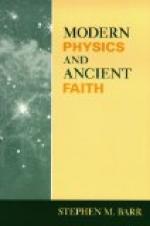As this ether is “physical” matter, the same as prakriti, one harmonic law covering both, and as this ether fills all space, Modern Science divides physical matter into two kinds, which, for convenience in differentiation, are here called prakritic and etheric.
Matter is something—science does not know or care to know what —in vibration. A very low octave of vibration produces prakriti; a very high octave of vibration produces ether. The vibration of prakriti ends in thousands; that of ether begins in billions. Between them there is a gulf of vibrations that has not yet been bridged. For that reason science divides matter into two “planes,” or octaves, of vibration—the matter of this visible and tangible plane being called prakriti and that of the invisible and intangible plane being called etheric. Across this gulf the two planes respond to each other, note for note, the note in trillions chording when the note in thousands is struck. Note for note, chord for chord, they answer one another, and the minutest and the most complex phenomena are alike the result of this harmonic vibration, that of the ether supplying Force and that of the prakriti a Medium in which it can manifest.
This knowledge of ether is not guesswork or fancy, and, while it is as impossible of proof as the axioms of geometry, it is worthy the same credence and honor. We are working on physical axioms exactly as we work on geometrical axioms.
Modern science represents each and every prakritic atom as a globe like the earth, floating in space and surrounded by an atmosphere of ether. “The subdivision of prakritic matter until we reach etheric atoms chemically united to make the physical unit” is the correct definition of an atom. The prakritic physical atom has length, breadth and thickness. And it has an atmosphere of ether which not only interpenetrates the atom as oxygen and hydrogen interpenetrate the drop of water, but furnishes it with an envelope as the oxygen and hydrogen furnish the drop of water with one.
Each physical atom is the centre of an etheric molecule composed of many etheric atoms vibrating at a greater or lesser speed and interpenetrating the atom. Each may be considered a miniature earth, with its aerial envelope, the air, penetrating all parts of it.
The etheric plane of matter not only unites with this prakritic plane through the atom but it interpenetrates all combinations of it; beside the atom as well as through the atom. The grain of sand composed of many prakritic atoms is also composed of many times that number of etheric atoms. The grain of sand is etheric matter as well as prakritic matter. It exists on the etheric plane exactly the same as it exists on the prakritic, and it has etheric form as well as prakritic form.
As each atom of this physical world of ours—whether of land, or water, or air; whether of solid, liquid or gas—is the centre of an etheric molecule, we have two worlds, not one: a physical world and an etheric one; a visible world and an invisible world; a tangible world and an intangible world; a world of effect and a world of cause.




